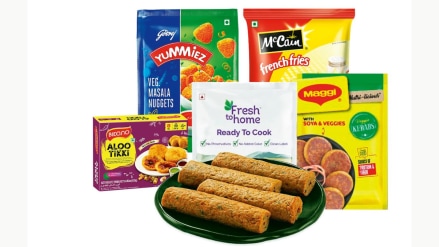The recent entry of Nestlé with veggie kebabs, achari pockets and special veggie pops has roiled the waters in the `16,730-crore frozen foods market in India. The FMCG behemoth isn’t the only player making waves; Godrej Tyson’s Yummiez brand is also doubling down on its commitment to convenience by unveiling plans to introduce a range of compact sachets and smaller packs for both vegetarian and non-vegetarian ready-to-cook products.
With the arrival of these new offerings, coupled with intense competition from other players, the segment is reshaping the way consumers approach meal preparation. What was once considered a niche market is now a hotbed of innovation, catering to the demands of a rapidly changing lifestyle landscape.
Anand Ramanathan, partner and leader, consumer products and retail sector, Deloitte India, says the presence of heavyweights ITC, Hindustan Unilever and McCain alongside a burgeoning B2B segment is indicative of the category’s potential.
Advancements in cold chain infrastructure, heightened awareness of global culinary trends and enhanced accessibility through online retail and supermarkets gave this market the early push. Lisa Suwal, CEO, Prasuma, which came into its own during the Covid pandemic, says the pandemic momentum is unlikely to fizzle out. “Rapid urbanisation, increasing disposable incomes, evolving lifestyle preferences and changing dietary habits are driving the demand for convenient food options,” she says.
The evolution of online grocery platforms like BigBasket and Grofers is another factor impacting growth, points out Ramanathan. “These platforms are expanding their frozen food offerings, providing greater convenience to consumers, taking away market share from traditional brick-and-mortar retailers,” he says.
Experts reckon that competition will intensify as regional players and private-label brands throw their hats into the ring. Says Kush Aggarwal, head of marketing, Bikano, the ultimate beneficiary will be consumers as competition leads to innovation, variety and competitive pricing.
Challenges galore
While the potential is immense, players must work to remove the roadblocks on the way. The first of which is the problem of perception. “A big challenge is consumer skepticism regarding the freshness and nutritional value of frozen products, which is also clouded by safety concerns,” says Suwal of Prasuma. Here consumer education is a key first step to humanise the category.
Consumers also remain worried about the use of preservatives in the frozen items. To get around the problem, most national brands use innovative technology to ensure that their products remain fresh without compromising on taste. “Contrary to popular belief that preservatives are necessary to maintain freshness, brands are using new technologies to ensure that. For instance, we employ a quick freeze process, which involves instant freezing after manufacturing, preserving the natural taste and freshness of the product,” says Aditya Krishna, sales and marketing head, McCain Retail. For its part, D2C brand FreshToHome touts its ‘clean label’ snacks to counter the additive argument.
What might help is reminding the consumer of the wide use of frozen peas in our regular home cooking. Says Aggarwal of Bikano, “Look at it as cooking with frozen peas, harvested at peak ripeness and frozen immediately using technology that preserves their nutrients and flavours. They are then transported from distant farms to people’s freezers, where they await consumption at their convenience.”
Price sensitivity is a significant factor affecting buying behaviour in India, and frozen foods are often seen as more expensive than fresh alternatives. To make its products more affordable, Godrej Tyso- n’s Yummiez plans to focus on smaller packs, says Mohit Marwah, AVP, Godrej Tyson.
Another weak link in the growth story is India’s pinched cold chain infrastructure. Storing products at consistent temperatures of below -18°C is crucial to maintain quality, say experts. “The lack of infrastructure, including reliable electricity supply and cold chain storage facilities, poses a significant hurdle to the industry’s growth. This not only impacts product quality and shelf life but also contributes to higher production and distribution costs,” says Prasuma’s Suwal.
She adds that there is also a lack of awareness about food safety and hygiene practices in many parts of the country leading to contamination and spoilage. Resolving these issues is time-consuming, which means widespread adoption is not going to happen overnight.
